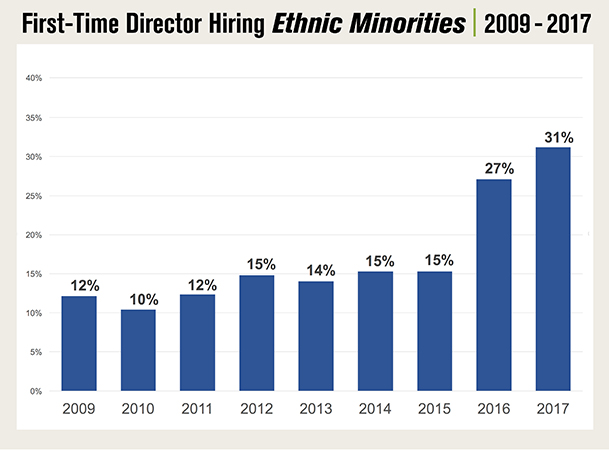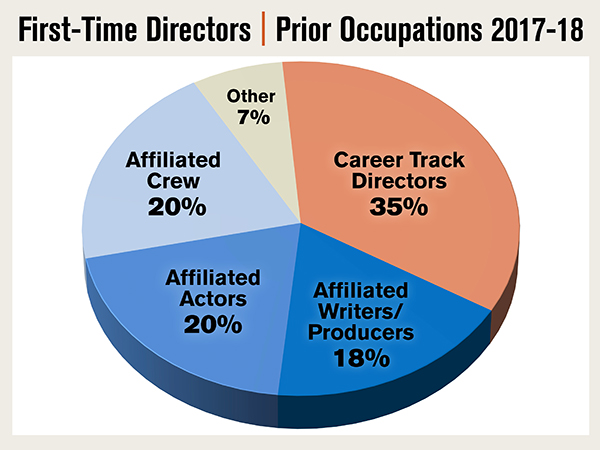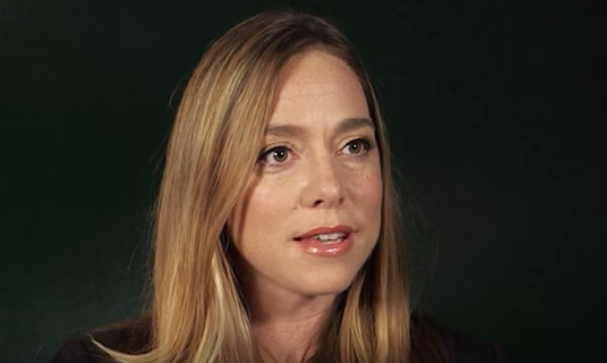Sometimes the fight to make the entertainment industry more inclusive can feel downright Sisyphean. Thankfully, that’s not always the case, as the Directors Guild of America’s (DGA) latest study shows. The union’s report on the first-time TV directors of the 2017-18 season found that the number of women and people of color making their episodic directorial debuts increased from 2016-17. In fact, this pool of first-time episodic directors was the most inclusive ever.

Credit: DGA
The number of women rose sharply from 33 percent in 2016-17 to 41 percent in 2017-18. Thirty-one percent of first-time TV helmers were POC, a four percent increase from the 2016-17 season. Thirteen percent of the new directors were women of color, up from nine percent in 2016-17.

Credit: DGA
“True inclusion is not just a single hire or a line in a speech, it’s a commitment that must be exercised through ongoing action, day by day. The hiring improvements covered in this report show an industry that’s headed in the right direction today, but also one with a long road ahead to keep up with the increasingly diverse world tomorrow,” said DGA President Thomas Schlamme. “What our study tells us is that there’s no shortage of talented women directors and directors of color ready for a first break. But for each hire to truly have an impact on the future, the studios and networks that make the hiring decisions need to open the doors even wider and discover a more inclusive population of candidates who seek directing as a career.”
The DGA publishes a report on first-time TV directors because getting a foot in the door is often one of the biggest challenges for women and POC working in show business. The guild also examines this pool of hires in order to understand if and how their directing careers evolve after their TV debuts.
“Inclusion is complicated by a hiring dynamic in the industry,” the report explains. “The study shows that while some actors, writers, and others connected to a series do pursue directing after a first-break opportunity, the vast majority do not. The ongoing employer practice of ‘gifting’ out directing jobs to these series-connected individuals who do not go on to pursue a career as a director has a damaging effect on new and established directors alike. The practice acts as a bottleneck to the pipeline, limiting first breaks for diverse directors.”
In other words, employers on a given show tend to do trusted cast or crew members favors in hiring them to direct, but that doesn’t mean said employees keep directing.

Credit: DGA
Overall, 202 first-time TV helmers were hired in 2017-18, a decrease from 2016-17’s all-time high of 225. Of these directors, 117 (58 percent) were “series affiliated,” meaning they had previously worked on the show as a writer-producer, actor, or crew member. Seventy (35 percent) of the first-time directors were “career-track directors,” i.e. had prior directing experience.
Building on past studies, the DGA found that, long-term, first-time affiliated directors are much less likely to pursue directing as a career. From 2009-10 to 2015-16, only 24 percent of affiliated first-timers went on to direct on series they were not affiliated with, as opposed to 71 percent of career-track directors. The pool of affiliated directors was also less diverse: only 25 percent of the group were women and POC, in contrast to the career-track’s 38 percent. Eighty-eight percent of career-track women directors continued to direct, as did 76 percent of POC directors.
“It seems rather clear: to bring real systemic change for the future — and not just stats from season to season — employers must give even more first opportunities to talented diverse voices committed to a career in directing,” Schlamme said. “It’s not just the right thing to do, it is vitally important to keep our industry growing, changing, and innovating.”
The push for inclusion has real momentum in the media, and the DGA’s research about first-time TV directors from this year and last indicate that this push is making a difference. Getting more women and minorities into creative roles can often feel impossible, but thanks to research, we know it’s not. It’s a matter of committing to inclusion.
Read the entire first-time TV directors study on the DGA’s website.







